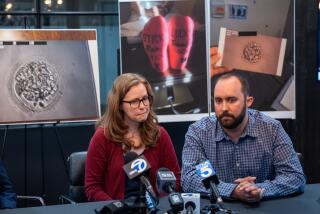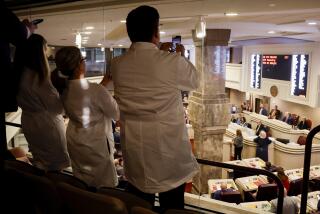Legacy of Dead L.A. Couple : OK Granted to Implant 2 Disputed Frozen Embryos
- Share via
Two frozen embryos left behind by a wealthy Los Angeles couple who died in a 1983 plane crash will be offered to other childless couples in Australia, the minister of health for the Australian state of Victoria has finally decided.
But that decision may be moot, according to U.S. fertility experts.
Even in the best of cases now, only about one in 20 frozen embryos yields a live birth, according to Geoffrey Sher of the Pacific Fertility Center in San Francisco and other experts. On average, 50% of frozen embryos do not survive the thawing process, and most of the remainder either do not become established in the womb or are miscarried.
Further, they noted, the success rate in 1981, when the Los Angeles couple’s embryos were frozen, was only about half as great.
“I’d guess that the chances of success are 2% to 3% at most,” said Richard Paulson, director of in-vitro fertilization at the USC School of Medicine.
Researchers are not completely sure why frozen embryos do not survive, Paulson said, but the main problem seems to be formation of ice crystals that disrupt cellular structures.
Mario Rios, a manager of low-income housing in Los Angeles, and his second wife, Elsa, were unable to have children because Rios had undergone a vasectomy after he and his first wife had a son.
In 1981, Elsa Rios traveled to Melbourne’s Queen Victoria Medical Center to undergo a then-new procedure called in-vitro fertilization. Physicians there removed three eggs from her, fertilized them with sperm from an anonymous donor and implanted one in her womb. She miscarried and never returned to have the procedure repeated.
The other two were frozen for storage.
In April, 1983, the couple died in a plane crash in the Andes outside Santiago, Chile. They were thought to have been returning to the United States with an adopted child, but the child’s body was never found.
Their deaths left Australian physicians with the problem of what to do with the two frozen embryos. They had two primary options, both potentially controversial: destroy the embryos or implant them in childless couples and run the risk of a lawsuit from the executors of the Rios estate.
The latter problem was obviated by a 1985 Los Angeles Superior Court ruling that the executors of the estate had no legal say over the fate of the embryos. Probate Commissioner Robert J. Blaylock also ruled that children born from the embryos would not be heirs to the estate.
The medical center decided to keep the embryos in storage until a government-appointed committee studying the ethics of in-vitro fertilization could make a recommendation. As a result of the study, Victoria passed the Infertility (Medical Procedures) Act, which takes full effect early next year.
The act states that embryos produced artificially can be destroyed or used for experiments only within the first 22 hours after conception.
As a result of that act, the Minister for Health, David White, said Thursday in a telephone interview that he will direct the medical center to find a suitable recipient for the embryos.
Times staff writer George Ramos contributed to this story.
More to Read
Sign up for Essential California
The most important California stories and recommendations in your inbox every morning.
You may occasionally receive promotional content from the Los Angeles Times.










